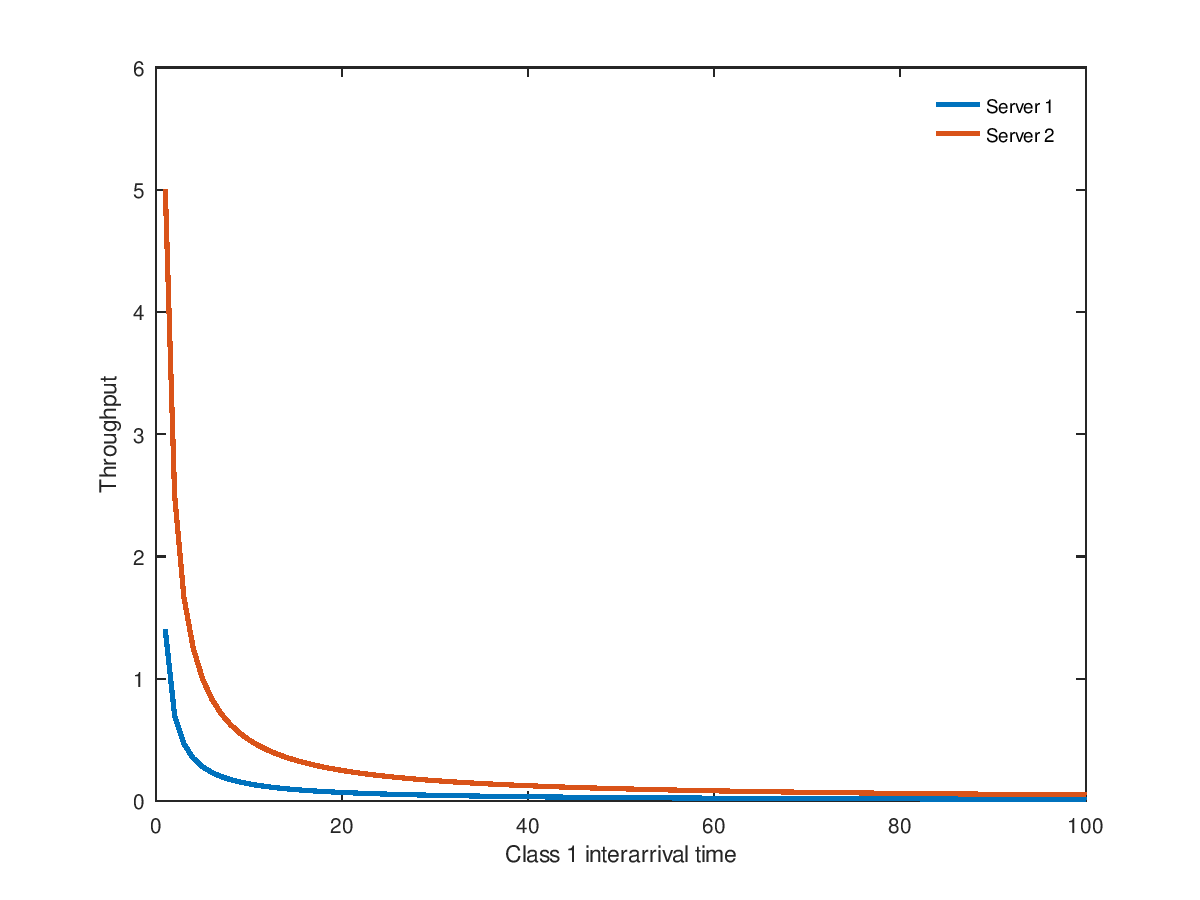- Function File: [U, R, Q, X] = qnom (lambda, S, V)
- Function File: [U, R, Q, X] = qnom (lambda, S, V, m)
- Function File: [U, R, Q, X] = qnom (lambda, S, P)
- Function File: [U, R, Q, X] = qnom (lambda, S, P, m)
-
Exact analysis of open, multiple-class BCMP networks. The network can be made of single-server queueing centers (FCFS, LCFS-PR or PS) or delay centers (IS). This function assumes a network with K service centers and C customer classes.
INPUTS
lambda(c)If this function is invoked as
qnom(lambda, S, V, …), thenlambda(c)is the external arrival rate of class c customers (lambda(c) ≥ 0). If this function is invoked asqnom(lambda, S, P, …), thenlambda(c,k)is the external arrival rate of class c customers at center k (lambda(c,k) ≥ 0).S(c,k)mean service time of class c customers on the service center k (
S(c,k)>0). For FCFS nodes, mean service times must be class-independent.V(c,k)visit ratio of class c customers to service center k (
V(c,k) ≥ 0). If you pass this argument, class switching is not allowedP(r,i,s,j)probability that a class r job completing service at center i is routed to center j as a class s job. If you pass argument P, class switching is allowed; however, all servers must be fixed-rate or infinite-server nodes (
m(k) ≤ 1for all k).m(k)number of servers at center k. If
m(k) < 1, enter k is a delay center (IS); otherwise it is a regular queueing center withm(k)servers. Default ism(k) = 1for all k.
OUTPUTS
U(c,k)If k is a queueing center, then
U(c,k)is the class c utilization of center k. If k is an IS node, thenU(c,k)is the class c traffic intensity defined asX(c,k)*S(c,k).R(c,k)class c response time at center k. The system response time for class c requests can be computed as
dot(R, V, 2).Q(c,k)average number of class c requests at center k. The average number of class c requests in the system Qc can be computed as
Qc = sum(Q, 2)X(c,k)class c throughput at center k.
NOTES
If the function call specifies the visit ratios V, class switching is not allowed. If the function call specifies the routing probability matrix P, then class switching is allowed; however, all nodes are restricted to be fixed rate servers or delay centers: multiple-server and general load-dependent centers are not supported. Note that the meaning of parameter lambda is different from one case to the other (see below).
REFERENCES
- Edward D. Lazowska, John Zahorjan, G. Scott Graham, and Kenneth C. Sevcik, Quantitative System Performance: Computer System Analysis Using Queueing Network Models, Prentice Hall, 1984. http://www.cs.washington.edu/homes/lazowska/qsp/. In particular, see section 7.4.1 ("Open Model Solution Techniques").
See also: qnopen,qnos,qnomvisits.
Demonstration 1
The following code
P = zeros(2,2,2,2);
lambda = zeros(2,2);
S = zeros(2,2);
P(1,1,2,1) = P(1,2,2,1) = 0.2;
P(1,1,2,2) = P(2,2,2,2) = 0.8;
S(1,1) = S(1,2) = 0.1;
S(2,1) = S(2,2) = 0.05;
rr = 1:100;
Xk = zeros(2,length(rr));
for r=rr
lambda(1,1) = lambda(1,2) = 1/r;
[U R Q X] = qnom(lambda,S,P);
Xk(:,r) = sum(X,1)';
endfor
plot(rr,Xk(1,:),";Server 1;","linewidth",2, ...
rr,Xk(2,:),";Server 2;","linewidth",2);
legend("boxoff");
xlabel("Class 1 interarrival time");
ylabel("Throughput");
Produces the following figure
| Figure 1 |
|---|
 |
Package: queueing